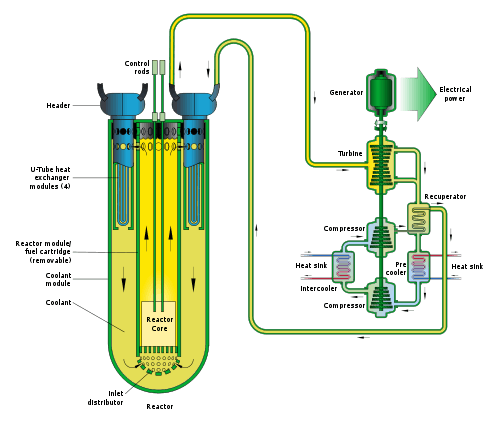MYRRHA

The MYRRHA (Multi-purpose hYbrid Research Reactor for High-tech Applications) is a "first of its kind" design project of a nuclear reactor coupled to a proton accelerator (a so-called Accelerator-driven system (ADS)). MYRRHA will be a lead-cooled fast reactor with two possible configurations: sub-critical or critical.
The project is managed by SCK•CEN, the Belgium center for nuclear energy research. It will be built based on the experience gained from the first successful demonstration project: GUINEVERE.[1] In 2013, the project entered a new phase and the front-end engineering design was contracted out to a consortium led by French multinational group specializing in nuclear and renewable energy, AREVA.[2][3]
MYRRHA has an international recognition and has been listed in December 2010 by the European Commission as one of 50 projects to make Europe the leader in high-tech research in the next 20 years.[4]
MYRRHA is a research reactor aiming to demonstrate the feasibility of the ADS and the lead-cooled fast reactor concepts, with various applications from spent-fuel burning to material irradiation testing.[5]
MYRRHA was intended to be operational in 2008.[6]
Special features
Accelerator
The ADS concept consists of coupling a subcritical reactor core with a proton accelerator. The neutrons missing from the sub-critical core in order to sustain the chain reaction originate from the spallation reaction of high energy proton beam with a heavy metal target. In order to operate a subcritical core with multiplication factor of k=0.95, a particle accelerator able to provide a maximum current of 4 mA beam of 600 MeV protons is needed. The option of a LINAC is currently preferred.
Due to the extreme rarity of such a stable accelerated proton beam, the MYRRHA project decided to include a fundamental physics experiment called Isol@MYRRHA[7] using a fraction of the proton beam.
Spallation target
The spallation reaction requires a high Z material, chemical elements with a high atomic number (Z) of protons in the nucleus, as a target. For the MYRRHA project, the coolant itself (eutectic liquid lead-bismuth) is foreseen in a windowless design. Windowless target necessitate to create a flow that will form a jet regime around the beam line output. It reduces the attenuation of the beam, but it is complex to maintain the jet regime around the beam line without interfering on the quality of the void in the pipes. Besides, lead is a very dense fluid.
Fuel elements
Mixed oxide fuel (MOX) with an enrichment of 35% is planned to be used in the core. Austenitic stainless steel cladding allows for good corrosion resistance along with known behavior in the nuclear industry.
Subcritical core
An important feature is the flexibility of MYRRHA, allowing two possible core configurations: subcritical or critical.
Three slots are left empty at the center of the core to allow space for the spallation target or for material irradiation. The subcritical core has an effective multiplication factor of 0.95: this is a unique feature in the world of nuclear reactors and will allow very innovative applications for MYRRHA such as actinides burning or very long cycle operation.
Mechanical design
MYRRHA is a pool type lead-bismuth reactor; therefore the mechanical features will be a very heavy core, atmospheric pressure for primary. The coolant is very corrosive but operating temperature is quite low. An additional constraint is the opacity of lead-bismuth.
Towards validation
Recently, MYRRHA has entered a new phase in the validation process, with two new experiments aimed at providing insight into the thermo-hydraulic and resistance to earthquakes.[8]
The EU Commission has supported MYRRHA in the past and can earmark funds in 2016 for it.[9]
Second phase of Front-end Engineering and Design is (as of May 2015) expected to commence in September 2015.[10]
See also
References
- ↑ Science Magazine, " Reactor-Accelerator Hybrid Achieves Successful Test Run"
- ↑ World Nuclear News, "MYRRHA accelerates towards realisation"
- ↑ AREVA official website, "AREVA TA WINS CONTRACT FOR THE MYRRHA PROJECT"
- ↑ European Commission, "Targeting nuclear waste with a proton beam"
- ↑ IAEA website, " MYRRHA, An innovative and unique irradiation research facility"
- ↑ , page 46
- ↑ Isol@MYRRHA
- ↑ "Deux installations test dédiées au futur réacteur nucléaire MYRRHA" [Two test facilities dedicated to future nuclear reactor MYRRHA]. L'echo (in French): 6. 31 January 2014.
- ↑ http://eur-lex.europa.eu/legal-content/DA/TXT/HTML/?uri=OJ:JOC_2014_405_R_0001&rid=1#d1e8712-1-1
- ↑ https://www.gen-4.org/gif/upload/docs/application/pdf/2015-06/5-6-1_lead_fast_reactor_lfr.pdf